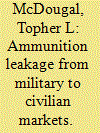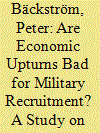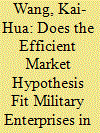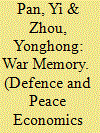|
|
|
Sort Order |
|
|
|
Items / Page
|
|
|
|
|
|
|
| Srl | Item |
| 1 |
ID:
170217


|
|
|
|
|
| Summary/Abstract |
The increase in the accessibility of firearms and ammunition represents a key factor of destabilization in many countries. It is also commonly associated with an escalation in intensity and organization of collective and interpersonal violence. In some cases, arms are illegally transferred via diversion from existing stores. In this article, we consider the leakage from military to civilian markets as an important source of ammunition available to civilians in Haiti. We employ a unique section-quarterly panel of ammunition prices on the Haitian civilian market over the period July 2004–July 2012. These data are combined with publicly available monthly data on authorized ammunition shipments to the country registered by the United Nations (UN) and Haitian National Police (HNP). We use a standard time-series Ordinary Least Squares (OLS) model to show that the exogenous shocks of UN- and HNP-ordered ammunition exert measurable downward pressure on civilian ammunition markets, which we calculate in terms of adjusted predictions and partial elasticities of demand. These effects constitute econometric evidence that the firewall that should in theory have separated military and civilian markets in Haiti partially broke down. We conclude with a suggestion for using this model to help estimate the specific size of the leakage.
|
|
|
|
|
|
|
|
|
|
|
|
|
|
|
|
| 2 |
ID:
170218


|
|
|
|
|
| Summary/Abstract |
This paper represents the first effort to explore the relationship between civilian labour market conditions and the supply of labour to the military in the all-volunteer environment that Sweden entered after the abolishment of the peacetime draft in 2010. The paper investigates the effect of civilian unemployment on the rate of applications from individuals aged 18–25 to initiate basic military training, using panel data on Swedish counties for the period 2011–2015. A linear fixed-effects model is estimated to investigate the relationship, while controlling for a range of socio-demographic covariates, unobserved heterogeneity on the regional level, as well as aggregate trends on the national level. The results of the panel-data analysis indicate that the unemployment rate has a positive and statistically significant effect on the application rate. These results are robust to non-linear form specifications, as well as allowing the civilian unemployment rate to be endogenous. As such, the results suggest that the civilian labour market environment in Sweden can give rise to non-trivial fluctuations in the supply of applications to initiate basic military training within the Swedish Armed Forces.
|
|
|
|
|
|
|
|
|
|
|
|
|
|
|
|
| 3 |
ID:
170216


|
|
|
|
|
| Summary/Abstract |
We estimated a stochastic growth model for Sri Lanka over the 1962–2015 period and found that permanent productivity shocks constituted the largest proportion of the variance in output growth. We computed correlation coefficients between permanent productivity shocks and some variables and found a negative correlation between the shocks and the growth in migration outflows. The findings are consistent with the negative effect of civil war on economic growth from an exodus of skilled workers. We further investigated the factors that drive migration from Sri Lanka to a major migration destination, namely Australia, for educated and skilled Sri Lankans. We regressed the growth rate of the Sri Lankan-born population in Australia on a civil war dummy variable, per worker Australian gross domestic product (GDP), adjusted for the restrictiveness of Australian immigration policy and an estimated labour wedge that represents labour market inefficiency in Sri Lanka. We found that Sri Lankan immigrants in Australia increased with per worker GDP in Australia, civil war and labour market inefficiency in Sri Lanka. The finding suggests that excessive protection of insiders in the Sri Lankan labour market should be abolished to mitigate migration outflows that have continued since the end of the civil war.
|
|
|
|
|
|
|
|
|
|
|
|
|
|
|
|
| 4 |
ID:
170222


|
|
|
|
|
| Summary/Abstract |
This paper investigates whether the efficient market hypothesis (EMH) fits the Chinese military market using the Sequential Panel Selection Method (SPSM) and the Panel KSS unit root test with a Fourier function. We obtain evidence for structural shifts and non-linearity in the stock prices of the military industry in the Chinese stock market. Because sharp shifts and structural breaks are taken into account, the unit root hypothesis for most listed companies is rejected. Our result suggests that the Chinese military market is inefficient because of such factors as defense reforms, friction in the stock market, and irrational investors. We provide investment implications to enable future stock price movements to be predicted based on past behavior and enable trading strategies to be developed to earn abnormal returns. Meanwhile, Chinese defense enterprises should continue to implement industrial reforms, change their bureaucratic culture, and develop a market-oriented workforce.
|
|
|
|
|
|
|
|
|
|
|
|
|
|
|
|
| 5 |
ID:
170221


|
|
|
|
|
| Summary/Abstract |
This paper analyzes the impacting factors of the capital structure of military listed companies in China, based on the 2001–2015 panel data of 104 Chinese listed companies, and we explore practical approaches for Chinese private capital entering the military enterprises, given the strategy of the civil–military integration. We show that: (1) state-owned shares and domestic legal person shares negatively impact the capital structure of military enterprises and mainly show in non-current liability. While the foreign legal person shares and the shareholding ratio of executives and managers have no significant impact. (2) As for the financial indicators, coefficients of firm size, asset tangibility, and growth are positive, while those of profitability, non-debt tax shield, and growth opportunity are negative. (3) Given the civil–military integration strategy, equity financing imposes a negative impact on the capital structure of military enterprises. The negative impact increases, with the increase in military enterprises’ profitability, business risk, and growth opportunities, and with the decrease in military enterprises’ growth and firm size. (4) The negative impacts of equity financing are significant, if debt ratios of the military enterprises are too small or too large. While the state-owned shares only have significant negative impact on military enterprises whose debt ratios are too small. As a conclusion, we suggest private capital to prioritize the corporate bonds or short-term borrowing to enter the military industry, and choose smaller or medium-sized military enterprises with more growth opportunities and lower business risks.
|
|
|
|
|
|
|
|
|
|
|
|
|
|
|
|
| 6 |
ID:
170215


|
|
|
|
|
| Summary/Abstract |
This article examines the link between interregional inequality and civil conflict in a panel of 125 countries over the period 1993–2013. The results show that the level of interregional inequality has a positive and statistically significant effect on the incidence of civil conflict, which implies that countries with higher regional income disparities are more likely to experience internal violence. This result is not driven by a specific group of influential countries and is robust to the inclusion in the analysis of a substantial set of covariates that may affect both interregional inequality and civil conflict. Likewise, the observed link between regional income disparities and internal violence does not depend either on the estimation strategy or the measures used to quantify the degree of interregional inequality and the incidence of civil conflict within the various countries. These results suggest that policies designed to decrease the magnitude of regional income disparities may contribute to reducing the incidence of civil conflict.
|
|
|
|
|
|
|
|
|
|
|
|
|
|
|
|
| 7 |
ID:
170220


|
|
|
|
|
| Summary/Abstract |
Both research and development (R&D) and military expenditure are pivotal areas for any country’s economy. However, most countries tend to spend more on military because of global insecurity and power politics. Nevertheless, this study shows the merit of R&D investment and how it contributes to the national human capital. An analysis was undertaken on the gap between R&D and military expenditure considering the Human Development Index (HDI) and Gross Domestic Product (GDP) of 76 countries for a period of 15 years (2000–2014). Mixed effect models were applied to adjust the effect of six different continents. The results showed that HDI has a positive bi-directional significant relationship with higher R&D investment. National spending on R&D builds human capital, which in turn contributes to public development over the years, unlike military expenditure that only marginally contributes towards GDP and makes no contribution to HDI.
|
|
|
|
|
|
|
|
|
|
|
|
|
|
|
|
| 8 |
ID:
170219


|
|
|
|
|
| Summary/Abstract |
On the basis of a natural experiment related to the Great East Japan Earthquake in 2011, the present work empirically analyzes the relationship between historical events and current attitude and determines whether regions that suffered severely during the Japanese invasion in World War II expressed small concern during the earthquake. After controlling for geographical distance, bilateral trade, and political characteristics, a negative relationship is found between the duration of invasion and number of related deaths in the invaded regions and their governments’ efforts in assisting Japan after the earthquake. Further analysis shows that political similarity to Japan helped in assisting them after the earthquake, but this effect was reduced for regions that sustained many deaths during the Japanese invasion. In addition, a mediation effect test shows that the help extended by Japan to several countries after the war through the Japanese official development assistance did not positively influence the amount of aid provided by such regions to Japan after the earthquake. These studies provide new evidence of the long-lasting influence of war. However, no robust evidence is found about the relationship between death rate and war memory. Therefore, even large countries cannot tolerate serious suffering during painful historical events.
|
|
|
|
|
|
|
|
|
|
|
|
|
|
|
|
|
|
|
|
|